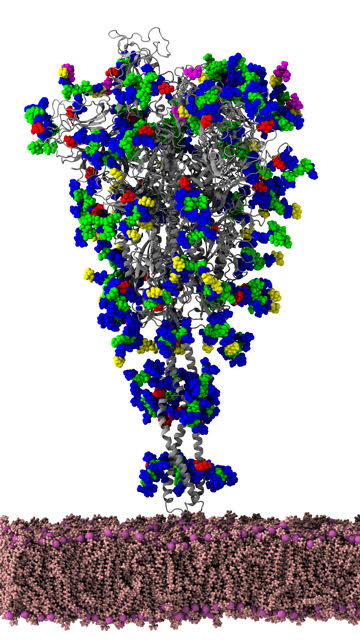 Glycoscience
GlycoscienceGlycans in Drug Discovery - HIV Glycopeptide Antigens
Glycoproteins found at the surface of several viruses are called viral envelope glycoproteins and they are great targets for virus neutralization.
By Mislav Novokmet, Maja Pučić Baković, Gordan Lauc

Coronaviruses have been around for centuries. The 21st century brought three known to cause severe human disease and global transmission concerns: SARS-CoV in 2002; MERS-CoV in 2012; and most recently SARS-CoV-2, which arose in 2019, causing an international pandemic. Given the substantial morbidity and mortality rates associated with COVID-19, there is an urgent demand for effective therapeutics and vaccines to control and diminish the epidemic.
Ongoing vaccine development efforts have primarily focused on the coronavirus transmembrane spike (S) glycoprotein, which extends from the viral surface and mediates host cell entry. A critical step in this crosstalk between the virus and the host cell is binding of S-glycoprotein to the ACE2 receptor on the surface of human cells. Not surprisingly, this virus-receptor binding affinity is under intensive study.
Both the S-glycoprotein and ACE2 receptor are known to be extensively glycosylated, i.e. they contain covalently linked complex oligosaccharides called glycans. Recently published papers have shown that the spike glycoprotein contains 66 glycosylation sites with 44 of them being included in the model.(1) Another recent study analyzed site-specific N-linked glycosylation of MERS and SARS S glycoproteins, indicating that each of these glycosylation sites can be occupied by up to ten different glycans (called glycoforms), which greatly extends epitope diversity.(2)
Because of their chemical complexity and limited throughput and sensitivity of existing analytical instruments, glycans are often overlooked. This is unfortunate as they determine a significant part of the overall structure and function of many glycoproteins. This is especially true in the field of host/pathogen interactions, where glycan diversity is used by both host to evade recognition by pathogens and the pathogens to escape the immune system response. Furthermore, glycans, and in particular their outermost parts, have significant conformational flexibility. This contributes to overall conformational dynamics of the molecule that can both generate novel potential drug binding sites or shield binding sites predicted from polypeptide-only models.

Structure of the SARS-CoV-2 glycoprotein with polypeptide part in grey and glycans in colour.
[Lorenzo Casalino, Zied Gaieb, and Rommie Amaro, UC San Diego]
It is not trivial to analyze and quantify glycans or to understand the cause and consequence of observed changes, but it is essential to include glycans in all studies to see the whole picture. One of the best-known antiviral drugs, Tamiflu, is directed towards inhibiting the enzyme that cleaves sialic acid on the surface of human cells, thereby interfering with the virus’ ability to infect the host.
Previous studies have shown that while the disruption of ACE2 glycosylation did not affect its expression on the cell surface and binding of SARS-CoV S-glycoprotein, viral entry into cells was impaired, resulting in reduced production of infectious virions.(3) It remains to be seen whether a smaller alteration in ACE2 glycan profile, like varying levels of sialic acid due to the inter-individual variation, could influence virus-receptor binding affinity and provide evidence for a different viral response within the population. Unfortunately, at the moment even studies published in prominent journals are made on recombinant proteins expressed in non-native cells, which prevents proper attribution of the role of glycans in this interaction.(4)
Out of a dozen or more potential drugs to treat SARS-CoV-2 infection already in clinical trials, one well known antimalarial drug, chloroquine, and its alternative hydroxychloroquine, have hit the front pages. Both compounds efficiently inhibit SARS-Cov-2 infection in vitro by increasing the pH of intracellular organelles and altering the glycosylation profiles of ACE2 receptor, thus interfering with host-cell entry and subsequent virus replication.(5,6) All of these mechanisms show the importance of understanding the role of glycosylation for the development of potential new treatments and especially for the development of new vaccines. Furthermore, different vaccines induce different glycosylation patterns of antibodies, which affect their ability to activate effector functions and provide protection against future infection.(7)
We need to intensify studies on the role of glycosylation and understand the importance of these complicated structures if we want to have success in the diagnosis, treatment, and prevention of the COVID-19.
Originally published in Genetic Engineering and Biotechnology News on April 1st, 2020
The authors are research scientists at the University of Zagreb and Genos Glycoscience Research Laboratory in Zagreb, Croatia.
References
1. Wrapp, D. et al. Cryo-EM structure of the 2019-nCoV spike in the prefusion conformation. Science (80-. ). 367, 1260–1263 (2020).
2. Watanabe, Y. et al. Vulnerabilities in coronavirus glycan shields despite extensive glycosylation. bioRxiv 2020.02.20.957472 (2020). doi:10.1101/2020.02.20.957472
3. Zhao, X. et al. Inhibition of endoplasmic reticulum-resident glucosidases impairs severe acute respiratory syndrome coronavirus and human coronavirus NL63 spike protein-mediated entry by altering the glycan processing of angiotensin I-converting enzyme 2. Antimicrob. Agents Chemother. 59, 206–216 (2015).
4. Lan, J. et al. Crystal structure of the 2019-nCoV spike receptor-binding domain bound with the ACE2 receptor. Nature 1–20 (2020). doi:10.1101/2020.02.19.956235
5. Liu, J. et al. Hydroxychloroquine, a less toxic derivative of chloroquine, is effective in inhibiting SARS-CoV-2 infection in vitro. Cell Discov. 6, 16 (2020).
6. Zhou, D. OUP accepted manuscript. J. Antimicrob. Chemother. 4–7 (2020). doi:10.1093/jac/dkaa114
7. Mehta, N. & Alter, G. Opportunities to exploit antibody glycosylation in vaccination. Future Virol. 12, 325–328 (2017).
By Mislav Novokmet, Maja Pučić Baković, Gordan Lauc

Start or continue your GlycanAge journey
Don’t be afraid to reach out to us and ask questions, provide commentary or suggest topics.
Other articles you may like:
 Glycoscience
GlycoscienceGlycoproteins found at the surface of several viruses are called viral envelope glycoproteins and they are great targets for virus neutralization.
 Glycoscience
GlycoscienceIgG glycosylation is an important part of antibody-based drug production since it offers insights into the drug’s efficacy along with a more accurate prediction of the patient’s immune response to the drug.